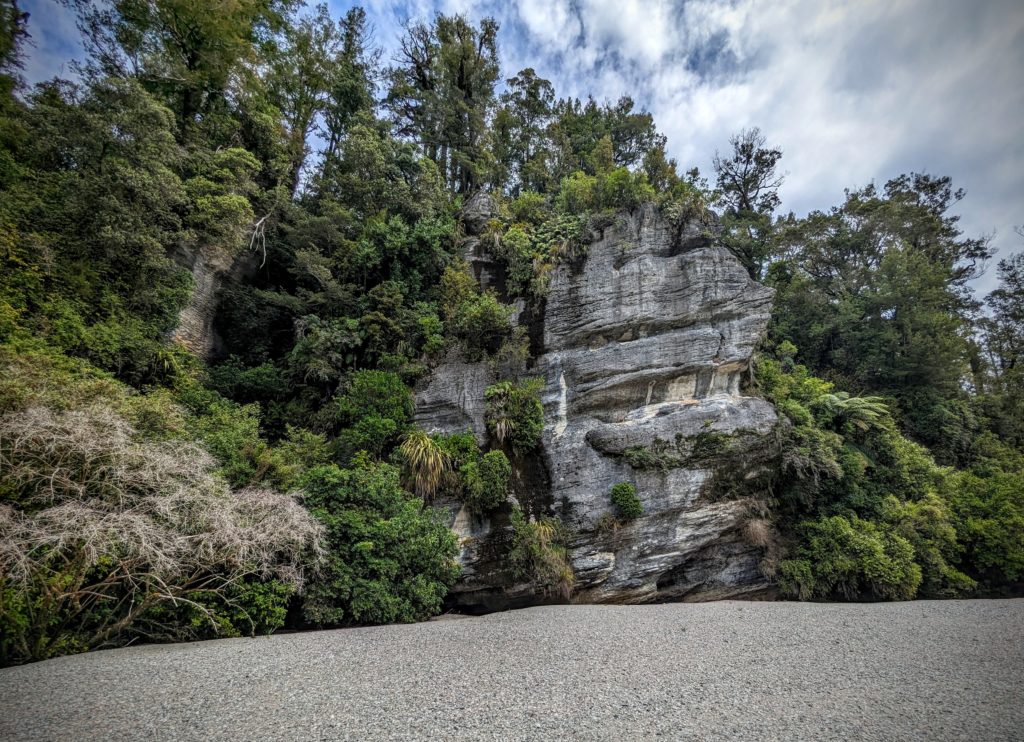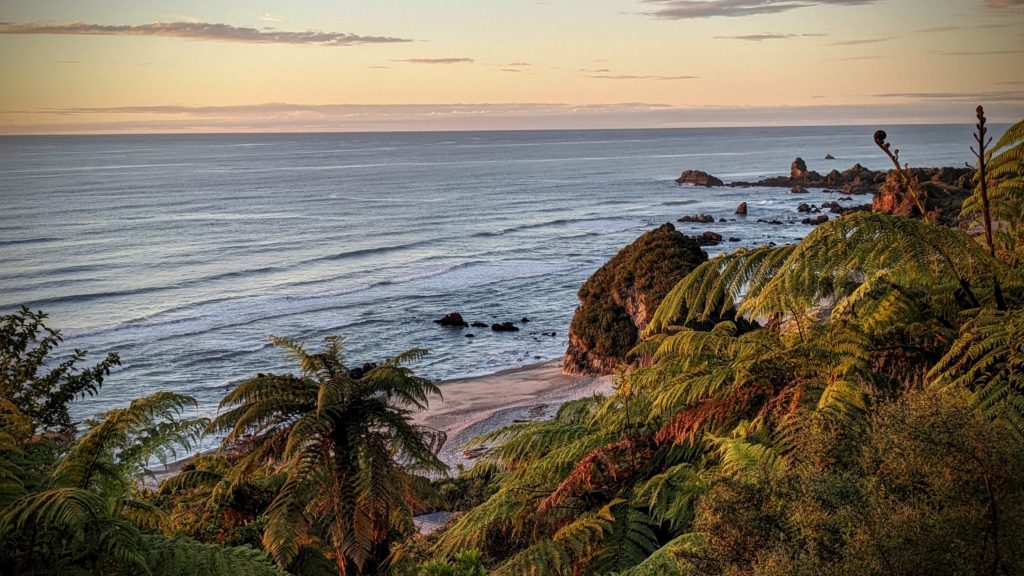February 27 Walk in the Woods (Day 153)
We headed inland from the beach along the Fox River today, on the Inland Pack Track, into the woods. The woods here being a native forest of podocarps, broadleaved trees and tree ferns sprinkled with palm trees, very similar to the forests we encountered on the North Island! We even found kawakawa, our favorite munching leaves, growing into trees here! Prehistoric and tropical looking, the forest is well watered with frequent rain and the air tempered with warm ocean humidity. The Paparoa Range rises up from the beach and is the first in a series of ranges that culminates in the Southern Alps, the backbone of the South Island. The wet weather arrives from the Tasman Sea, rises up to coat the Alps with snow in the winter, creating a rainshadow desert on the east side (the drier Ashburton Lakes area), and several river valleys carved down the west side to empty their waters back to the Tasman Sea, the Fox River being one of them.

The beginning of the track was promising, with what looked like rock pavers!
We tramped through the woods on a wide track until it curved closer to the river where the bank has slipped and slid and crumbled. We picked our way over wet gullies, stepped on and over gnarled roots, climbed down and up slippery, muddy banks and emerged on a sandy, cobbley beach.

Looking across the river at the tall podocarp old-growth trees towering over the smaller trees, palms and tree ferns.
Back into the woods on a better track we reached a water crossing that was quite impassable for us so we turned back.

The orange triangle in the lower left across the river is the track, you can only get there by wading in the water!
We had only hiked 2.8 miles round trip and we had more to do! We drove south a little bit to Bullocks Creek Road and drove up the 6km (3.7 miles) gravel road to about midway point on the Inland Pack Track.

This is where the prehistoric feeling about the forest really got strong! We expected pterodactyl birds to fly overhead, brontosaurus to amble by, munching the treetops, or King Kong to emerge on a clifftop!

Instead we got a curious local flightless Weka bird come to check out our shoes, even poking it’s head into them when we took a break for lunch! Note; most birds don’t have a sense of smell!
We had driven up the road along Bullocks Creek which was totally obscured by vegetation. When we started on the trail we still couldn’t find the creek!

It turns out that the creek goes underground, leaving this sandy riverbed that is filled by flash floods when it rains heavily!
The ground underneath us is limestone, ancient seabed, that has been tunneled, caved and eroded by water over eons. Many signs along the trail warn you not to leave the track as there are sinkholes, caverns and thin crusts that can cave in! A side trail, the Cave Creek Memorial Track leads off 3/4 of a mile to a chasm where Cave Creek emerges from underground. We took the trail to the stairway that takes you to the bottom of the chasm. The creek is very low now at the height of summer!

The stairway is to the right behind Robert. The creek ’emergence’ is to the left.

upper photo;The ’emergence’ at the bottom of the chasm.
lower photo; A closer look
Cave Creek is the site of one of the worst tragedies in NZ history. In 1995 14 people from a school environmental study class died when a viewing platform at the top of the chasm gave way, crashing 100 feet down onto the rocks below. The ensuing investigation highlighted grave errors by the Department of Conservation on the design and construction of the platform and the gross underfunding of the Dept. that led to shortcuts and shoddy inspection and maintenance of structures throughout the Parks system. More information is HERE and a video describing the event and consequences is HERE. The track was renamed the Memorial Track after the tragedy and the platform was never rebuilt.
The second hike was 3.5 miles roundtrip, a total of 6.3 miles, so we deserved the beers back at home as we watched a fabulous sunset.

The sunset lighting up the haystack rock on the beach.
